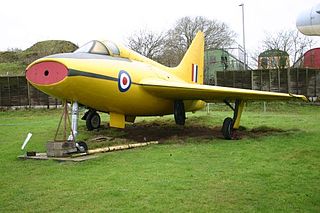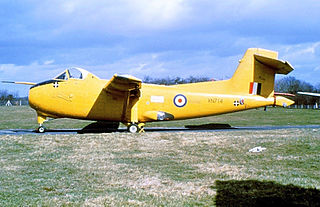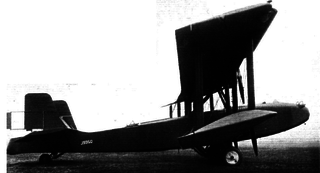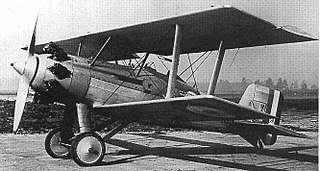
The Gloster Javelin is a twin-engined T-tailed delta-wing subsonic night and all-weather interceptor aircraft that served with Britain's Royal Air Force from the mid-1950s until the late 1960s. The last aircraft design to bear the Gloster name, it was introduced in 1956 after a lengthy development period and received several upgrades during its lifetime to its engines, radar and weapons, which included the De Havilland Firestreak air-to-air missile.

The empennage, also known as the tail or tail assembly, is a structure at the rear of an aircraft that provides stability during flight, in a way similar to the feathers on an arrow. The term derives from the French language verb empenner which means "to feather an arrow". Most aircraft feature an empennage incorporating vertical and horizontal stabilising surfaces which stabilise the flight dynamics of yaw and pitch, as well as housing control surfaces.

The Northrop N-1M, also known by the nickname "Jeep", is a retired American experimental aircraft used in the development of the flying wing concept by Northrop Aircraft during the 1940s.

The Boulton Paul P.111 is an experimental aircraft designed and produced by the British aircraft manufacturer Boulton Paul. It was amongst the first aircraft designed to explore the characteristics of the tailless delta wing configuration.

The Armstrong Whitworth A.W.52 was an early flying wing aircraft designed and produced by British aircraft manufacturer Armstrong Whitworth Aircraft.

The Hunting H.126 was an experimental aircraft designed and built by British aviation company Hunting Aircraft.

The Short SB.5 was a "highly unorthodox, adjustable wing" British research aircraft designed by Short Brothers in response to the UK Air Ministry requirement ER.100; to provide input for the design of the English Electric P.1 by testing the low speed flight characteristics of various configurations of wing-sweep required for supersonic flight. The tailplane could be mounted either on top of the fin ("T-tail") or below the fuselage. The tests ultimately confirmed that the original P.1/Lightning design was an effective configuration for high speed flight.

The Short SB.4 Sherpa was an experimental aircraft designed and produced by the British aircraft manufacturer Short Brothers. Only a single example was ever produced.

The Boulton Paul Balliol and Sea Balliol are monoplane advanced trainer aircraft designed and produced by the British aircraft manufacturer Boulton Paul Aircraft. On 17 May 1948, it became the world's first single-engined turboprop aircraft to fly. The Balliol was operated primarily by both the Royal Air Force (RAF) and the Royal Navy Fleet Air Arm (FAA).

Pterodactyl was the name given to a series of experimental tailless aircraft designs developed by G. T. R. Hill in the 1920s and early 1930s. Named after the genus Pterodactylus, a well-known type of Pterosaur commonly known as the pterodactyl, all but the first were produced by Westland Aircraft Ltd after Hill joined them.

The Arsenal VG 90 was a French carrier-based jet-engined interceptor developed in the late 1940s. It was intended to compete for an Aéronavale contract and first flew in 1949. It set a speed record for a French aircraft the following year, but both of the completed prototypes were destroyed in fatal crashes and the program was cancelled in 1952 before the third prototype was finished. The Aéronavale contract was eventually awarded to a license-built British aircraft. The remains of the last VG 90 were scrapped in 1978.

The Lockheed XF-104 Starfighter was a single-engine, high-performance, supersonic interceptor prototype for a United States Air Force (USAF) series of lightweight and simple fighters. Only two aircraft were built; one aircraft was used primarily for aerodynamic research and the other served as an armament testbed, both aircraft being destroyed in accidents during testing. The XF-104s were forerunners of over 2,500 production Lockheed F-104 Starfighters.

The OKB-1 150 was a jet bomber designed and produced in the Soviet Union from 1948.

The sole Boulton & Paul P.32 was a British three-engined biplane built to an Air Ministry specification for a long range night bomber. A lack of engine availability slowed construction and by the time it went for tests the thinking on bomber types had moved on.

The Boulton and Paul P.41 Phoenix, a single-engined two seat parasol monoplane, was aimed at the amateur private flyer and intended to cost less than the successful de Havilland Moth. Despite positive responses from its target purchasers, no orders were forthcoming and only one was built.

The Boulton & Paul P.33 Partridge was a single seat single-engined biplane fighter designed to an Air Ministry specification. One prototype was ordered and built for trials in 1928, but it was not put into production.
The Boulton & Paul P.12 Bodmin was an experimental British twin-engined biplane bomber with its engines mounted in a fuselage engine room and with tandem pairs of tractor and pusher airscrews mounted between the wings. The two Bodmins built flew in 1924, proving the concept but the layout was not developed to production.

The Boulton & Paul P.15 Bolton was a one-off experimental twin-engined reconnaissance biplane ordered by the Air Ministry to sustain Boulton & Paul's development of steel-framed aircraft early in the 1920s. It was the RAF's first metal-framed aircraft.

The Boulton & Paul P.8 Atlantic was Boulton & Paul's attempt to adapt their well-performing Bourges bomber into an airliner. They hoped to gain publicity for it by winning the outstanding prize for the first non-stop Atlantic crossing but a first flight accident made them miss their opportunity. Two were built but none sold as airliners.
The Boulton & Paul P.6 was a one-off conventional single-engined biplane built by Boulton & Paul Ltd to test the aerodynamics of different airfoil sections. It was later used as the company sales machine.


















